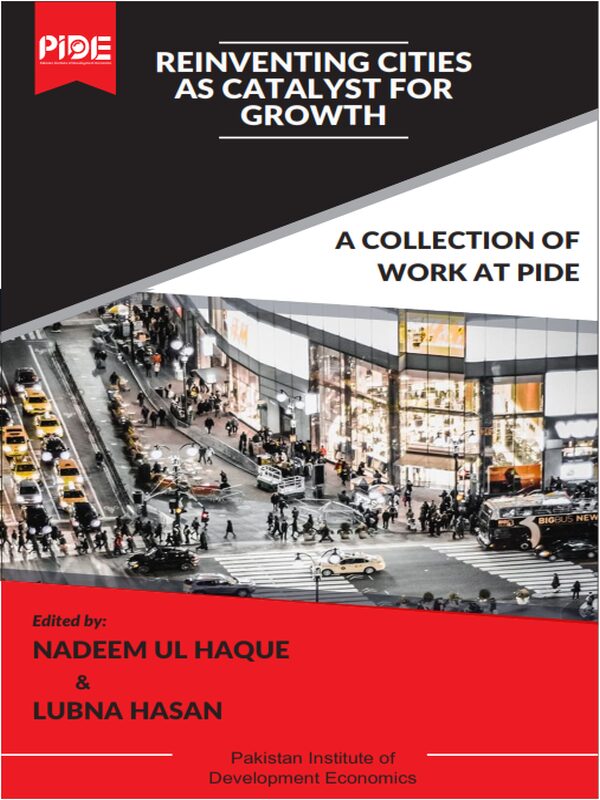Reinventing Cities as Catalyst for growth: A Collection of Work at PIDE
INTRODUCTION
Cities worldwide are the powerhouses of growth, commerce, innovation, productivity, and magnets for talent. They are the cradles of knowledge, entrepreneurship, science, and culture. While the world focuses on their cities to benefit from their positive externalities and minimise the negative impact (congestion, crime, and pollution), we, in Pakistan, have relegated cities and their governance issues to obscurity.
Research on cities and their management is scarce. Pakistan Institute of Development Economics took the lead in bringing this all-important research area to the mainstream back in 2006. This book is a compilation of recent cutting-edge research conducted at PIDE.
The first chapter, “Contextualising Pakistani Cities,” by Nadeem Ul Haque, sets the stage for a deeper understanding of Cities’ role in the contemporary world. He poignantly states that cities have been at the heart of development throughout history. They drive growth by enabling the exchange of goods, services, and ideas in a dense and mixeduse environment. He then draws a comparison of the world’s megacities – the magnets of growth – with the debilitating state of Pakistani cities. He argues that the Pakistani cities – a remnant of our colonial past – are the polar opposite of contemporary cities. Unlike a modern city, which is dense, walkable, with mixed-use and high-rise city centres, Pakistani cities are horizontal sprawl with sub-urban two-story housing, car dependence, absence of commercial and public spaces, and limited opportunities for entrepreneurship and the poor. The prime land in city centres is occupied by housing for the government, which takes precedence over commerce. The city administration lacks professionalism and is a continuation of the colonial past. Obsessed with maintaining the status quo, they rely on archaic zoning and building regulations that are exclusionary to the poor and detrimental to dense, walkable, mixed-use city centres. He emphatically argues that for cities to lead the growth process, city administrators must adopt a city-markets-governance framework.
The second chapter, “Cities in Human Life,” by Durr-e-Nayab, takes a historical view of the role of cities in shaping human life. She posits that cities, since antiquity, have been the centre of knowledge, learning, creativity, innovation, institutions, and government. High levels of human capital provide a potent force in cities, attracting and inspiring innovators. Cities are, thus, centres of growth because of the density, higher productivity, knowledge spillovers, and proximity of complementary economic activities, thus leading to economies of agglomeration and scale by offering larger markets. The paper investigates relevant literature on issues like cities’ evolution, definition, primacy and size, meta-geography, and future. Nayab believes that cities of the past have been successful either as cultural incubators or as technological innovators. Now, a new culture is expected to grow in urban areas through the synthesis of art and technology, further emphasising the role of cities.
In the third chapter, “The Flawed Urban Policy”, Nadeem ul Haque questions the myth of ‘rural Pakistan’ and argues for a shift toward growth-enhancing city-centric policy.
He contends that Pakistan is an urban country whose policy narrative refuses to accept this reality. The paucity of research on cities’ functionality, patterns, zoning, optimum size, architecture, globalisation, governance, urban sprawl, and the absence of an urban policy has stifled the growth potential of cities. Pakistani cities are dysfunctional, with suburban development and no downtown – dense areas of mixed-use (residential, office, commercial, and entertainment) within an almost walkable district. There is a shortage of essential spaces like offices, schools, restaurants, and libraries, which are being operated in residential buildings. The geographic spread of cities makes the provision of public transport an expensive affair, with the resulting dependence on cars. This car-centric approach makes road expansion (flyovers, underpasses, etc.) a big-ticket item in the development budget. He puts urban renewal at the heart of Pakistan’s growth revival. Relax the zoning laws and building controls in favour of dense, high-rise downtowns, encourage construction and real estate development, and let the ‘tower-cranes,’ the hallmark of metropolitan cities, dominate the skyline.
With the global consensus on devolution for improved and efficient provision of goods and services at the local level, the cities are under increased pressure to manage funds to perform these tasks. In the fourth chapter, “Increasing Revenue for Metropolitan Corporation Islamabad”, Nadeem ul Haque proposes a plan for generating a revenue stream for Islamabad. He explains the expectations a city government must fulfill, i.e., to provide jobs and growth, a healthy and safe environment, opportunities for all, and civic participation. For this, cities rely on options that encompass a) property taxes, b) utility payments, c) user charges, d) value creation through urban regeneration and land value capture, e) proactive use of its assets (sports and community centres) and being more cognizant of their wealth. He argues that most of the national wealth is situated in cities in terms of real estate, creativity, entrepreneurship, and markets. Every city has assets that are potential sources of revenue but are poorly managed. Of this, land is the most precious asset held by a city, which is often given over to suboptimal uses, including houses for officials on prime land, golf clubs and polo grounds, railway, and metro stations. Urban regeneration through creative destruction and rezoning can be used to capture this wealth. Based on these principles, he proposes a revenue plan for the Metropolitan Corporation of Islamabad, with an estimated revenue stream from each source.




